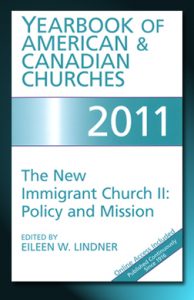Earlier this week the National Council of Churches released its annual analysis of church membership: 2011 Yearbook of American and Canadian Churches. According to the Rev. Dr. Eileen Lindner, editor, the data in this year’s report suggests that recent membership trends have continued: “That is, churches which have been increasing in membership in recent years continue to grow and likewise, those churches which have been declining in recent years continue to decline.”
The yearbook reports a total church membership of 145,838,339 members, which is down 1.05 percent over 2010. The ten traditions with the largest current membership are
 The Catholic Church: 68.5 million, up 0.57 percent.
The Catholic Church: 68.5 million, up 0.57 percent.- Southern Baptist Convention: 16.1 million, down .42 percent.
- The United Methodist Church: 7.8 million, down 1 percent.
- The Church of Jesus Christ of Latter-day Saints: 6 million, up 1.42 percent.
- The Church of God in Christ: 5.5 million, no membership updates reported.
- National Baptist Convention, USA: 5 million, no membership updates reported.
- Evangelical Lutheran Church in America: 4.5 million, down 1.96 percent.
- National Baptist Convention of America, 3.5 million, no membership updates reported.
- Assemblies of God: 2.9 million, up .52 percent.
- Presbyterian Church (USA): 2.7 million, down 2.61 percent.
So What?
Membership decline in mainline denominations continues and isn’t limited to the traditions large enough to make the top ten list:
Mainline churches reporting declines in membership are United Church of Christ, down 2.83 percent to 1,080,199 members; the Presbyterian Church (USA), down 2.61 percent to 2,770,730 members; the Episcopal Church, down 2.48 percent to 2,006,343 members; the Evangelical Lutheran Church in America. down 1.96 percent to 4,542,868 members; the American Baptist Churches USA, down 1.55 percent to 1,310,505; the Lutheran Church (Missouri Synod), down 1.08 percent to 2,312,111 members; and the United Methodist Church, down 1.01 percent to 7,774,931 members.
Did your denomination fare better or worse than average (1.05 percent decline)?
Many mainline denominations are considering significant changes (i.e. nFOG in the PCUSA and UGov in the UCC). Do you believe this type of change will be helpful in shifting from decline to growth? Why or why not?